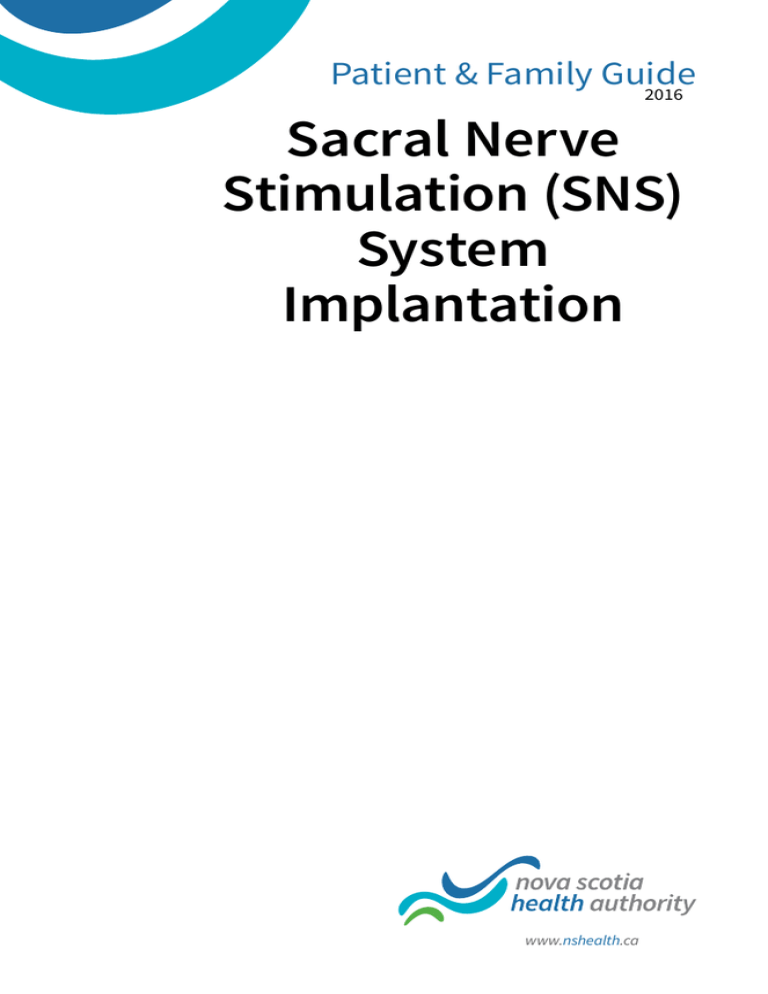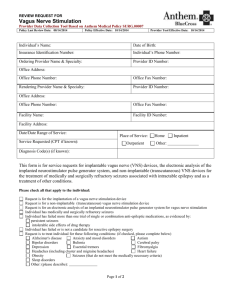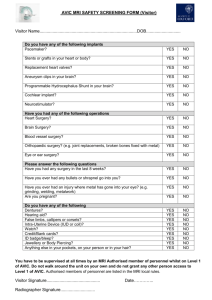Sacral Nerve Stimulation (SNS) System Implantation
advertisement

Patient & Family Guide 2016 Sacral Nerve Stimulation (SNS) System Implantation www.nshealth.ca Sacral Nerve Stimulation (SNS) System Implantation SNS system implantation involves placing a lead (“leed”, or wire) through the skin in your lower back to the nerves stimulating muscles and organs in your pelvis. The lead is connected to a battery called a neurostimulator that is placed under your skin. The neurostimulator is a small electronic device similar to a heart pacemaker. The neurostimulator delivers electrical stimulation to the nerve in your pelvis which helps control urinary function. The neurostimulator can help with the function of your bladder. What is sacral nerve stimulation (SNS)? Sacral nerve stimulation (SNS) has been an approved treatment option in Canada since 1994. This treatment can improve one or more symptoms such as: ›› Frequent trips to the bathroom during the day and night. ›› Urine (pee) leakage. ›› Bladder emptying. ›› Pain and pressure in the bladder area. 1 If your doctor feels SNS may help you and Peripheral Nerve Evaluation (PNE) tests showed good results, you will be scheduled for day surgery. You will be admitted to the hospital overnight. The surgery is called SNS system implantation. During the surgery, a wire is placed in your lower back and connected to a neurostimulator. The neurostimulator is placed under the skin in your buttock or lower abdomen through a small incision (cut). What is the sacral nerve stimulation (SNS) system like? The system consists of a lead placed through the skin into an existing hole in the sacrum (a bony plate near the end of your spine). Another incision is made in the upper buttock to create a pocket in the fatty layer of subcutaneous (under the skin) tissue. The neurostimulator fits into this pocket. An extension cable under the skin attaches the lead to the neurostimulator. The stimulation is felt as a twitching or fluttering sensation in the area of the vagina or rectum in women, and rectum or scrotum in men. Occasionally this stimulation feeling may travel to the leg. If the leg stimulation becomes painful, turn your stimulator down or off and call your healthcare provider. 2 The procedure • Placing the SNS system will take about 1 hour, and you will be admitted to the hospital overnight. Your procedure will be at the urology Operating Room (OR) at the Victoria General (VG) site. • You can bring a family member or friend to provide support before the procedure. • You will be admitted to the hospital after your surgery. • Your doctor will give you a general anesthetic (medicine to put you to sleep). • Next, a needle will be placed into your lower back to find the proper placement in the sacrum. • Your doctor will check your response based on the muscle contractions in your buttocks or your big toe. • Once the correct sacral nerve and responses have been confirmed, a lead will be inserted through the same needle. • Another incision will be made in the upper buttock to create a “pocket” in the fatty layer of tissue. The neurostimulator will be placed into this pocket. • The lead will tunnel under the skin to connect to the neurostimulator. An extension cable will be attached to the lead. 3 • The incisions will then be closed with staples and covered with a dressing. The stimulator will be left deactivated (turned off). • An X-ray will be taken to check the location of the lead. • Before discharge, the device will be turned on and your doctor or nurse will show you how to use the patient programmer, which is used to control the neurostimulator. They will also tell you about the safety measures and activity restrictions related to the SNS system. What happens after surgery? • You may feel some discomfort and pain in the first few days after surgery. You should take the medications prescribed by your doctor for pain relief. • You can go back to your normal activities slowly once you have less discomfort. • You will be asked to make an appointment with your family doctor for removal of staples 12-14 days after surgery. • The neurostimulator stays in your body and you will be able to adjust the intensity and turn it off if needed. 4 Care of the neurostimulator • Before you leave the hospital, you should be able to turn your device ON and OFF and increase or decrease sensation using your patient programmer. • If you have any problems, turn the stimulator off and contact your doctor’s office. • From time to time, the neurostimulator might require reprogramming to make sure it is working well. This will be done at the outpatient Urology Clinic by your urologist or a nurse. • The neurostimulator will usually need to be replaced every 5-10 years. A minor procedure is needed to change the neurostimulator. Warnings: • If you are pregnant, or if you plan on becoming pregnant, your stimulation should be turned off. • Do not have shortwave diathermy (electrically induced heat), microwave diathermy, or therapeutic ultrasound diathermy. This may result in serious injury or death. 5 • MRI testing with your neurostimulator in place should be avoided because of the potential effects of the MRI magnetic field on the neurostimulator, extension, and lead. Talk about this with your urologist. • It is possible that theft detectors and airport/ security screening devices may make your neurostimulator switch ON or OFF. If you are sensitive or have a low stimulation threshold, you may feel a momentary increase in how you feel the stimulation. These higher levels of stimulation have been described as uncomfortable, “jolting”, or “shocking”. This is nothing to worry about. • This therapy is not intended for you if you have a mechanical obstruction (blockage) such as an enlarged prostate, cancer, or a urethral obstruction. • Safety and effectiveness are not known for patients under the age of 16. • Cardioverter defibrillators, electrocautery (heating tissue with electricity), external defibrillators, ultrasonic equipment, and radiation therapy may be adversely affected or cause interference with the neurostimulator. 6 Are there risks? • There is a small risk of skin erosion or irritation over the site of the implanted neurostimulator or lead. This could lead to infection requiring antibiotics or possible removal or relocation by surgery. • There is a small risk of wound infection. • Very rarely (less than 1%) there could be a hematoma (blood clot) which could lead to fever and abscess formation. • There is a small risk that the neurostimulator might not work due to electronic or mechanical failure. This might require a minor surgical procedure to replace all or part of the SNS system. • There is a chance that the lead or extension might move or fracture or the device may malfunction after implantation. This could lead to a sensation of electrical shock, possibly causing pain or muscle spasms. These risks are unlikely. Should one occur, you may need another surgery. There is about a 30% risk of needing a second surgery because the SNS system doesn’t work correctly, the lead moves, or there is a problem at the connection site. About 2 out of 10 patients find that SNS does not help, or they find that it makes their voiding (peeing) problems worse. 7 Caution: • Call your doctor if you see any redness or swelling at the lead site. This could be a sign of infection. • When you see any of your healthcare providers, tell them that you have a SNS system. • Ask your doctor what to do if you feel a change in the stimulation. It should never be painful. If it is painful, turn it down or off and call your healthcare provider. • If the SNS system gets uncomfortable, turn it off, and then slowly turn it up again until you feel moderate stimulation. It does not need to be strong, but you should feel something. Stimulation may feel different when you change your body position. For more information, please contact: Urology Clinic 1796 Summer Street, 4th floor Phone: 902-473-4186 8 If you have any questions, please ask. We are here to help you. Notes: 9 Looking for more health information? This pamphlet and all our active patient pamphlets are searchable here: http://bit.ly/NSHApamphlets Contact your local public library for books, videos, magazines, and other resources. For more information go to http://library.novascotia.ca Nova Scotia Health Authority promotes a smoke-free, vape-free, and scent-free environment. Please do not use perfumed products. Thank you! Nova Scotia Health Authority www.nshealth.ca Prepared by: Urology Clinic © Designed by: Nova Scotia Health Authority, Central Zone Patient Education Team Printed by: Dalhousie University Print Centre The information in this brochure is for informational and educational purposes only. The information is not intended to be and does not constitute healthcare or medical advice. If you have any questions, please ask your healthcare provider. WJ85-1608 Updated February 2016 The information in this pamphlet is to be updated every 3 years or as needed.






